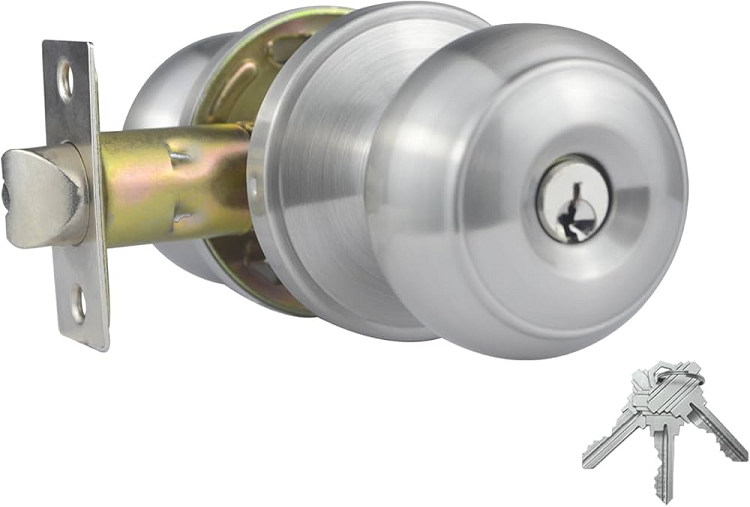The Evolution Of Doorknobs In The Home: From Functionality To Fashion
2025-02-19 10:31
The seemingly simple doorknob is, in fact, a remarkable illustration of innovation, craftsmanship, and historical development. Although it appears to be a basic mechanism, the design and materials of doorknobs have transformed over the centuries, mirroring changes in technology, aesthetics, and societal trends.

At its core, a Door Knob is an ingenious little device. The traditional design consists of a knob that operates a spindle, which is connected to a cylinder. When the knob is turned, the spindle moves, pulling the cylinder in the direction of the turn. The cylinder is connected to a latch, which protrudes into a recess in the doorframe, keeping the door closed. The latch prevents the door from opening unless the knob is turned. While this mechanism is simple, the engineering behind it is surprisingly intricate, and modern advancements have made these systems both more reliable and versatile.
Early Beginnings: From England to the American Revolution
Interestingly, America didn’t initially produce doorknobs or any other hardware until well after the American Revolution. During colonial times, the English held a monopoly over manufacturing, restricting the colonies to providing only raw materials for finished products that were then sold back to them. This included essential hardware like doorknobs and latches. The colonies were not allowed to create or import finished hardware items themselves, which delayed the development of doorknobs in America.
However, after the Revolution, American ingenuity began to flourish. As the nation transitioned from an agrarian society to an industrial powerhouse, the first major innovations in doorknob production began to take shape. One key advancement was the invention of the glass pressing machine, patented in 1826. This new technology allowed manufacturers to mass-produce decorative Glass Door Knobs, making them more affordable and widely available. The mass production of glass knobs marked a significant shift in the history of doorknob manufacturing in the United States.

The Rise of Glass: A Decorative and Practical Solution
By the mid-19th century, glass doorknobs had become a popular choice in American homes, particularly during the Victorian era. These knobs were not only functional but also highly decorative, often featuring intricate patterns and designs. The beauty of glass doorknobs made them a symbol of wealth and refinement, and they became a staple in many upper-class households. The decorative possibilities allowed homeowners to customize their doors with unique and ornate handles that complemented their home’s overall aesthetic.
However, this popularity of glass would not last forever. By the late 19th century, the use of metal materials like brass, iron, and bronze began to dominate doorknob design. The shift to metal was driven by the material’s durability and strength, which made it a more practical option for homes that required heavy-duty use.
World Wars and the Return of Glass
The early 20th century brought significant changes to the world’s economies, and the outbreak of World War I had an unexpected influence on doorknob production. As metal resources were diverted to the war effort to build planes, tanks, and other machinery, glass became a more readily available material for manufacturing. This scarcity of metals led to a resurgence in the popularity of glass doorknobs during the war years, as manufacturers sought alternative materials to meet the demand for functional hardware.
Glass doorknobs were widely used during both World War I and World War II, particularly because they were easier to produce with the limited materials available. The simplicity of glass production, combined with its aesthetic appeal, made it a desirable choice for both builders and homeowners. This period also saw the rise of colored glass knobs, which allowed for even more customization and personal expression in home decor.

The 1950s and Beyond: The Return to Metal and the Age of Customization
After World War II, the demand for glass began to wane as metals became more accessible once again. By the 1950s, homeowners and builders began to favor metals once more, and materials like chrome, brass, and Stainless Steel Door Knob became the go-to choices. This period marked the start of a new era in which function and durability were prioritized, but aesthetic preferences also played a significant role.
Today, the choices for doorknobs are virtually limitless. Modern technology allows for an incredible variety of styles, shapes, and finishes that can complement any home decor. Doorknobs and levers come in finishes like satin nickel, brushed chrome, oil-rubbed bronze, antique brass, and matte black, offering endless options for customization. Whether it’s a sleek, modern knob or a vintage-inspired design, the options available today cater to every taste and budget.
Conclusion
While doorknobs may seem like a minor detail in the grand scheme of home design, their evolution over the years speaks to broader technological advancements, cultural shifts, and changing social norms. What started as a simple mechanism to open doors has transformed into a decorative and functional piece of hardware that adds personality and flair to the entryways of homes around the world. Whether simple or ornate, classic or contemporary, the doorknob continues to be an essential part of our everyday lives.

 Like Us on Facebook to enjoy 5% discount
Like Us on Facebook to enjoy 5% discount